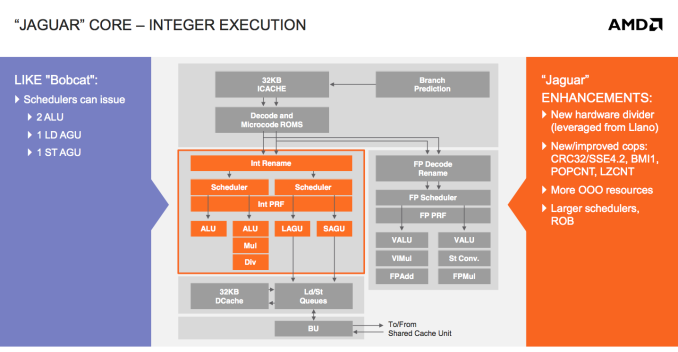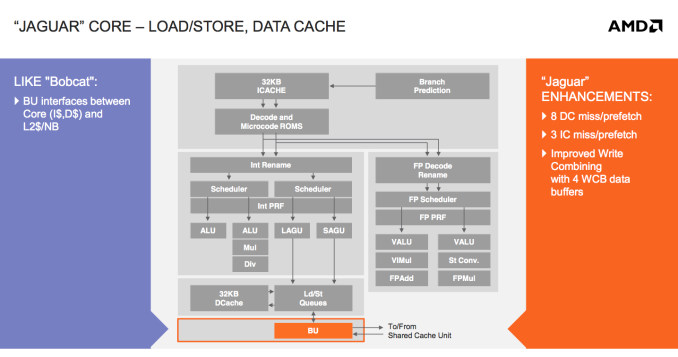AMD’s Jaguar Architecture: The CPU Powering Xbox One, PlayStation 4, Kabini & Temash
by Anand Lal Shimpi on May 23, 2013 12:00 AM ESTInteger & FP Execution
On the integer execution side, units and pipelines look largely unchanged from Bobcat. The big performance addition here is the use of Llano’s hardware divider. Bobcat had a microcoded integer divider capable of one bit per cycle, while Jaguar moves to a 2-bits-per-cycle divider. The hardware is all clock gated, so when it’s not in use there’s no power penalty.
The schedulers and re-order buffer are incrementally bigger in Jaguar. Some scheduling changes and other out of order resource increases are at work here as well.
Integer performance wasn’t a huge problem with Bobcat to begin with, but floating point performance was a different issue entirely. In our original Brazos review we found that heavily threaded FP workloads were barely faster on Bobcat than they were on Atom. A big part of that had to do with Atom’s support for Hyper Threading. AMD addressed both issues by beefing up FP execution and doubling up the maximum number of CPU cores with Jaguar (more on this later).
Bobcat’s FP execution units were 64-bits wide. Any 128-bit FP operations had to be chunked up and worked on in stages. In Jaguar, AMD moved all of its units to 128-bits wide. AVX operations complete as 2 x 128-bit operations, while all other 128-bit operations can execute without multiple passes through the pipeline. The increase in vector width is responsible for the gains in FP performance.
The move to 128-bit vectors in the FPU forced AMD to add another pipeline stage here as well. The increase in FPU size meant that some signals needed a little extra time to get from one location to the next, hence the extra stage.
Load/Store
The out-of-order load/store unit in Bobcat was the first one AMD had ever done (Bobcat beat Bulldozer to market, so it gets the claim to fame there). As such there was a good amount of room for improvement, which AMD capitalized on in Jaguar. The second gen OoO load/store unit is responsible for a good amount of the ~15% gains in IPC that AMD promises with Jaguar.














78 Comments
View All Comments
blacks329 - Thursday, May 23, 2013 - link
I know its definitely not that high for any individual platform, but I do remember a lot of major publishers, Ubi, EA and a bunch of other smaller studios had said (early-mid gen) that because porting to PS3 was such a nightmare and resource intensive, that it was more efficient to spend extra resources initially and use the PS3 as the lead and then have it ported over to 360, which was significantly easier.While I'm sure quite a large chunk still use 360's as their lead platform, I would say 90% was probably very early in this gen and since then has dropped to be much closer between 360 and PS3.
Although at this point both architectures are well understood and accounted for that most engines should make it easier to develop for both regardless of what platform is started with.
mr_tawan - Sunday, May 26, 2013 - link
I don't think using x86 would benefit the dev as much as many expected. Sure using the same hw-level arch may simplify the low-level code like asm, but seriously, I don't many of devs nowaday uses asm intensively anymore. (I had been working for current-gen console titles for a little, and never write even a single line of asm). Current-gen of game is complex, and need the best software architecture, otherwise it would lead to delay-to-death shipping schedule. Using asm would lead to premature optimisation that gains little-to-nothing.What would really affect the dev heavily is sdk. XB1 uses custom OS, but the SDK should be closed to Windows' DirectX (just like XB360). PS4, if it's in the same fashion as PS3, would use the custom-made SDK with OpenGL/OpenGL ES API (PS3 uses OpenGL ES, if I'm not mistaken). It needs another layer of abstration to make it easier to make it fully cross-platform, just like the current generation.
The thing that might be shared across two platform might be the shader code, if AMD can convince both MS and Sony to use the same language.
That's only guesses, I might be wrong.
mganai - Thursday, May 23, 2013 - link
That, and Intel's been making a bigger push for the smartphone market; it even says so in the article!Silvermont should change things up quite favorably.
mschira - Thursday, May 23, 2013 - link
Well all this is pointless if nobody makes good hardware using it.It's the old story. The last generation Trinity would have allowed very decent mid range notebooks with very long battery run time and more than sufficient power at reasonably low costs.
Have we seen anything?
Nope.
So where is a nice 11" Trinity Laptop?
Or a 10" Brazos?
All either horrible cheap Atom or expensive ULV core anything.
Are the hardware makers afraid that AMD can deliver enough chips?
Are they worried stepping on Intels toes?
Are they simply uncreative all running in the same direction some stupid mainstream guide tell them?
I suspect it is largely the latter - and most current notebooks are simply uncreative. The loss of sales comes to no surprise I think. And its not all M$ fault.
M.
Mathos - Thursday, May 23, 2013 - link
It could be another instance of Intel paying oems to not use certain AMD parts. They've done it before, wouldn't be surprised if it happens again in area's where AMD might have a better component.But it's also not totally true, having worked at Wal-Mart and other big chain stores, I can tell you that many do carry laptops and ultrathins that use Trinity A series chips, and Brazos E series chips. But, right now, everyone still wants that ipad or galaxy tab. And in general the only people I saw buying laptops and ultrathins were the people during the back to school or back to college crowds. And of course black Friday hordes.
And with AMD having both next gen consoles under their belt, them and many OEMs may be able to leverage that to draw sales of jaguar based systems.
Gest - Saturday, May 25, 2013 - link
So does Jaguar have new (any) hardware instructions that intel processors don't? (Will intel add them in haswell?) I think game makers will use them actively during the consoles lifetime.scaramoosh - Monday, May 27, 2013 - link
Doesn't this just mean the console CPU power is lacking compared to what PCs currently have?Silma - Wednesday, May 29, 2013 - link
Absolutely.